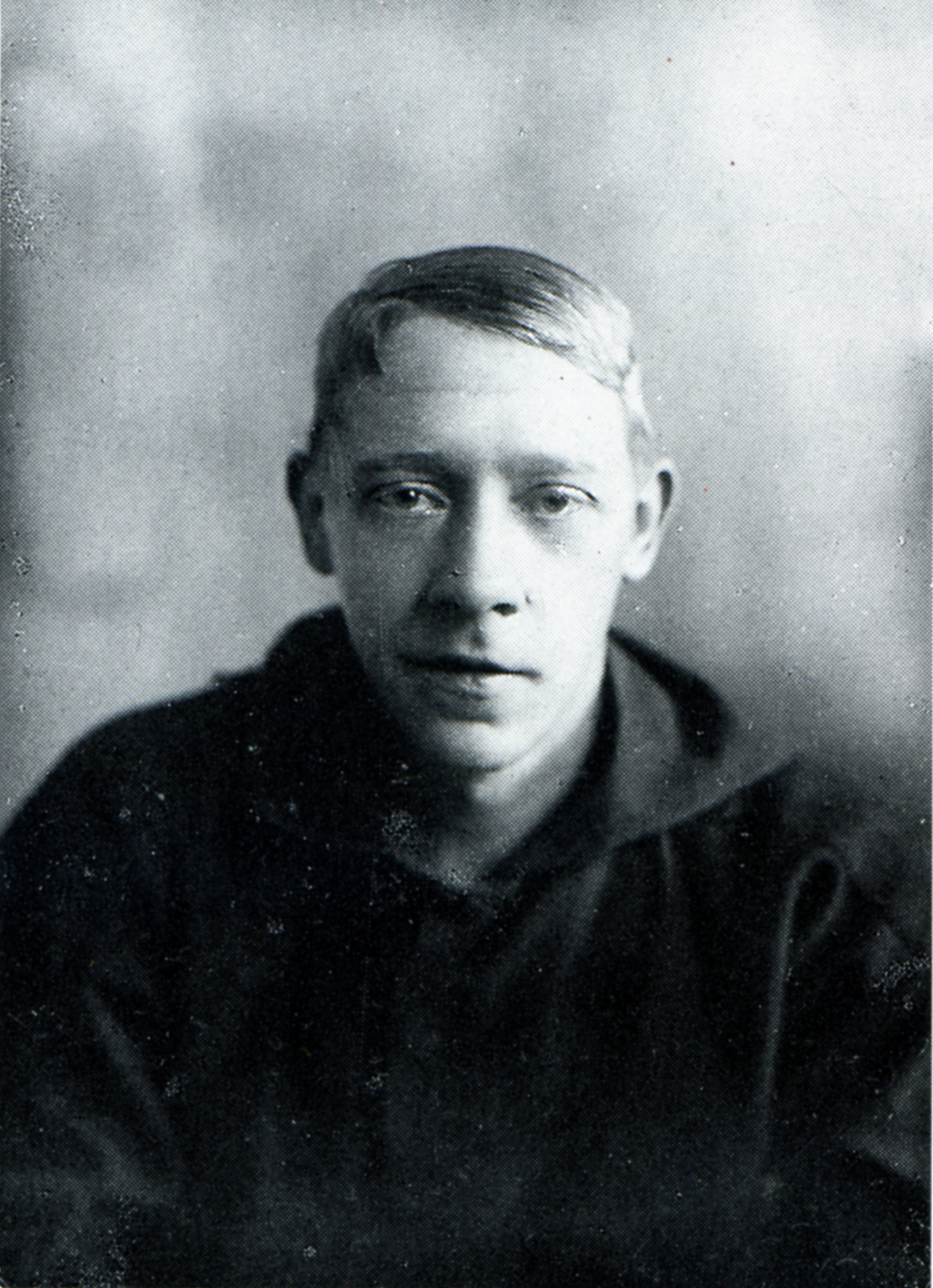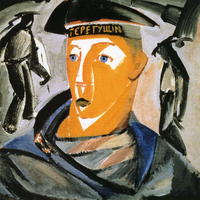More about Vladimir Tatlin
Works by Vladimir Tatlin

Contributor
Painter and architect Vladimir Tatlin just got ripped off by Amazon. Let me tell you how.
Amazon just constructed a spiraling structure, which sits in Arlington, Virginia, near its headquarters. Originally called the Helix, it looks eerily similar to Tatlin’s Monument to the Third International, an unbuilt design Tatlin proposed back in 1919 for a quickly changing Russia. Since it was over a hundred years ago, we can confidently say Tatlin beat billionaire bro Jeff Bezos to the idea. Tatlin envisioned the structure to be Russia’s Eiffel Tower not some over designed office building.
Originally titled Monument to the October Revolution of 1917, Tatlin’s tower appealed to the new Soviet government as a monument to the Bolshevik Revolution.The tower was to revolve and have media projected upon its form. It was to be 396 meters tall and made of steel and glass. Alas, in a time of social upheaval, the tower struggled to attain funding, materials, and leadership. State money was needed elsewhere.
Before he was Soviet Russia’s poster child for art, Tatlin had big dreams. He had a short stint as a sailor in his twenties, when he had the idea of creating a da Vinci-esque flying apparatus. Although he never realized his dream of seeing Letatlin fly, the model now hangs from the ceiling of Moscow’s Tretyakov Gallery.
Tatlin formed the Constructivist movement along with fellow Soviet artist Alexander Rodchenko as a response to social changes happening in their country. With Wassily Kandinsky, Tatlin taught at (get ready for it) VKHUTEMAS, a hell of an abbreviation for the Higher Art and Technology Studios, which acted as Russian educational institutes that opened and operated inseveral cities. He taught in art programs all through Leningrad, Moscow, and Kyiv between 1923 and 1930. Finally, in 1930, Stalin-era repression scared students and teachers into destroying their own work. Some artists didn’t survive Stalin’s wrath and were executed by firing squad. Tatlin lived, but was effectively expelled from his artistic life.
Although he was a supporter of the Soviet dream, and the idea that art should be accessible to the masses, Tatlin was a major fan of certain artists from the West. One time, Tatlin even evaded Soviet guards just to meet Pablo Picasso. Back in 1914, being an avid admirer of Picasso, Tatlin fought hard to seek out the famed Spaniard. So how does a Soviet blocked from Western culture actually do this? It’s time for a covert mission:
- 1. Go undercover: As part of an ensemble, Tatlin hooked up with a Russian group of bandura players, a Ukrainian string instrument.
- 2. Travel: He joined said group and headed to Berlin as part of a performance for a Russian art exhibition.
- 3. The slip: Tatlin slipped into Paris to seek out the Cubist master.
- 4. Get help where you can: It’s believed Russian-French artist Marc Chagall helped Tatlin meet Picasso.
Cubism strongly influenced Tatlin’s work around this time, as can be seen in The Sailor and Portrait of the Painter.
Sources
- Antonova, Maria, “The bird-like Soviet flying machine that never quite took off,” Atlas Obscura, January 10, 2017. Accessed April 8, 2021. https://www.atlasobscura.com/articles/the-birdlike-soviet-flying-machin…
- Arens, Marianne, Fuchs, Sybille, “Tatlin’s ‘new art for a new world,’” World Socialist Web Site, June 19, 2012. Accessed April 8, 2021. https://www.wsws.org/en/articles/2012/06/tat1-j19.html
- Anna Begicheva, Natasha Kurchanova, Alexander Nagel, “How I remember Tatlin,” Anthology and Aesthetics, No. 63/64 (2013), pp. 299-313. Accessed May 19, 2021. https://www.jstor.org/stable/23647773?seq=1
- Brian Dillon, “Poetry of Metal,” The Guardian, July 25, 2009. Accessed May 19, 2021. https://www.theguardian.com/books/2009/jul/25/vladimir-tatlins-tower-st…
- Cheremushkin, Peter, “VKHUTEMAS is 100 at the Museum of Moscow,” The Moscow Times, March 10, 2021. Accessed April 8, 2021. https://www.themoscowtimes.com/2021/03/10/vkhutemas-is-100-at-the-museu…
- Christies, “A brief history of Constructivism,” April 15, 2019. Accessed May 20, 2021. https://www.christies.com/features/A-brief-history-of-Constructivism-98…
- Magdalena Dabrowski, “Tatlin and Cubism,” Notes in the History of Art, Vol. 11, No. ¾ (1992), pp. 39-46. Accessed May 20, 2021. https://www.jstor.org/stable/23203481?seq=1
- Fredrickson, Laurel, “Vision and Material Practice: Vladimir Tatlin and the Design of Everyday Objects,” Design Issues, Vol. 15, No. 1 (1999), pp. 49-74. Accessed May 19, 2021. https://www.jstor.org/stable/1511788?seq=1
- Grishin, Sasha, “The Russian avant-garde at the NGA is something of a revolution,” The Canberra Times, December 5, 2017. Accessed May 19, 2021. https://www.canberratimes.com.au/story/6025213/the-russian-avant-garde-…
- Khosla, Romi, “Celebration or reflection?” Frontline, December 22, 2017. Accessed April 8, 2021. https://frontline.thehindu.com/cover-story/celebration-or-reflection/ar…
- Larking, Matthew, “’Impossible Architecture’: consider the impossible – find the visionaries,” The Japan Times, January 25, 2020. Accessed May 20, 2021. https://www.japantimes.co.jp/culture/2020/01/25/arts/impossible-archite…
- Phillips, “Vladimir Tatlin: ‘Monument to the Third International.’” Accessed May 19, 2021. https://www.phillips.com/article/43416956/vladimir-tatlin-monument-to-t…
- Popova, Anna, “10 people and things connecting Pablo Picasso with Russia,” Russia Beyond, March 29, 2021. Accessed April 8, 2021. https://www.rbth.com/arts/333600-picasso-and-russia
- Quito, Anne, “Amazon’s Helix is the latest twist on spiral-shaped architecture,” Quartz At Work, February 5, 2021. Accessed April 8, 2021. https://qz.com/work/1967752/a-brief-history-of-helix-shaped-architectur…
- Randle, Chris, “The Soviets who wanted fashion for all,” Jacobin Magazine, May 9, 2021. Accessed May 20, 2021. https://jacobinmag.com/2021/05/soviet-accessible-fashion-clothing-russi…
- Alma Reyes, “Landscape of images and text: Constructivism in the 20th Century,” Tokyo Art Beat, February 16, 2021. Accessed May 20, 2020. https://www.tokyoartbeat.com/tablog/entries.en/2021/02/landscape-of-ima…
- Russia Beyond, “Top 10 Russian avant-garde artists that everyone should know (PICS),” November 14, 2019. Accessed April 8, 2021. https://www.rbth.com/arts/331274-russian-avant-garde-artists
- Vartanian, Hrag, “For the love of Constructivist Russia,” Hyperallergic, June 15, 2011. Accessed April 8, 2021. https://hyperallergic.com/26867/revolutionary-film-posters-tony-shafraz…
Featured Content
Here is what Wikipedia says about Vladimir Tatlin
Vladimir Yevgrafovich Tatlin (28 December [O.S. 16 December] 1885 – 31 May 1953) was a Russian and Soviet painter, architect, and stage-designer. Tatlin achieved fame as the architect who designed The Monument to the Third International, more commonly known as Tatlin's Tower, which he began in 1919. With Kazimir Malevich he was one of the two most important figures in the Soviet avant-garde art movement of the 1920s, and he later became an important artist in the constructivist movement.
Check out the full Wikipedia article about Vladimir Tatlin











